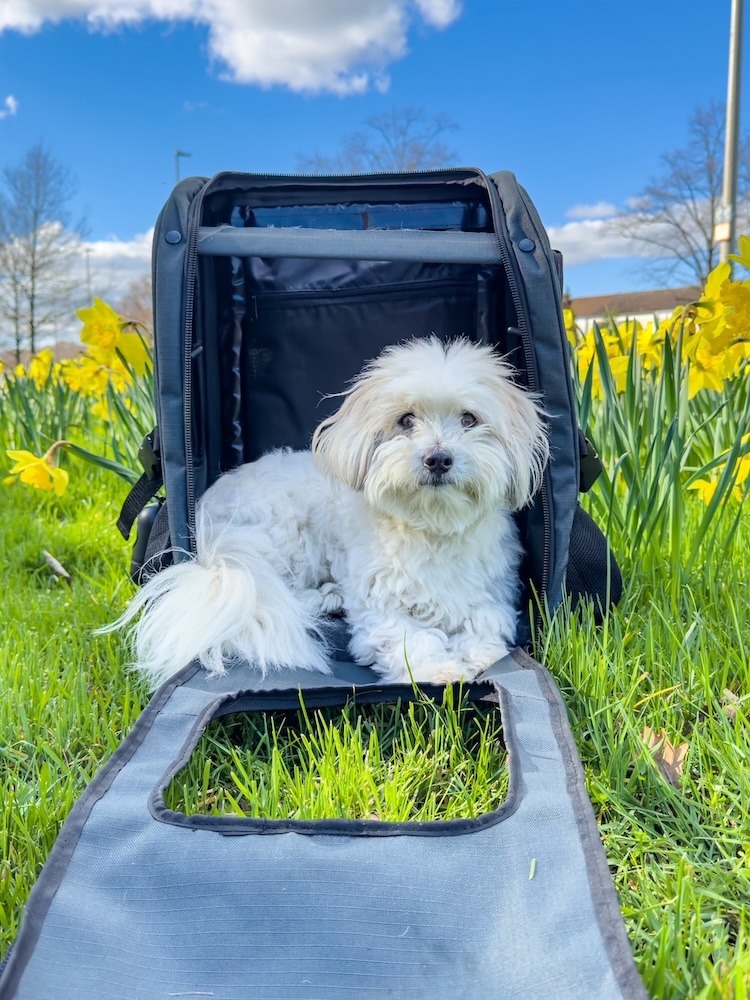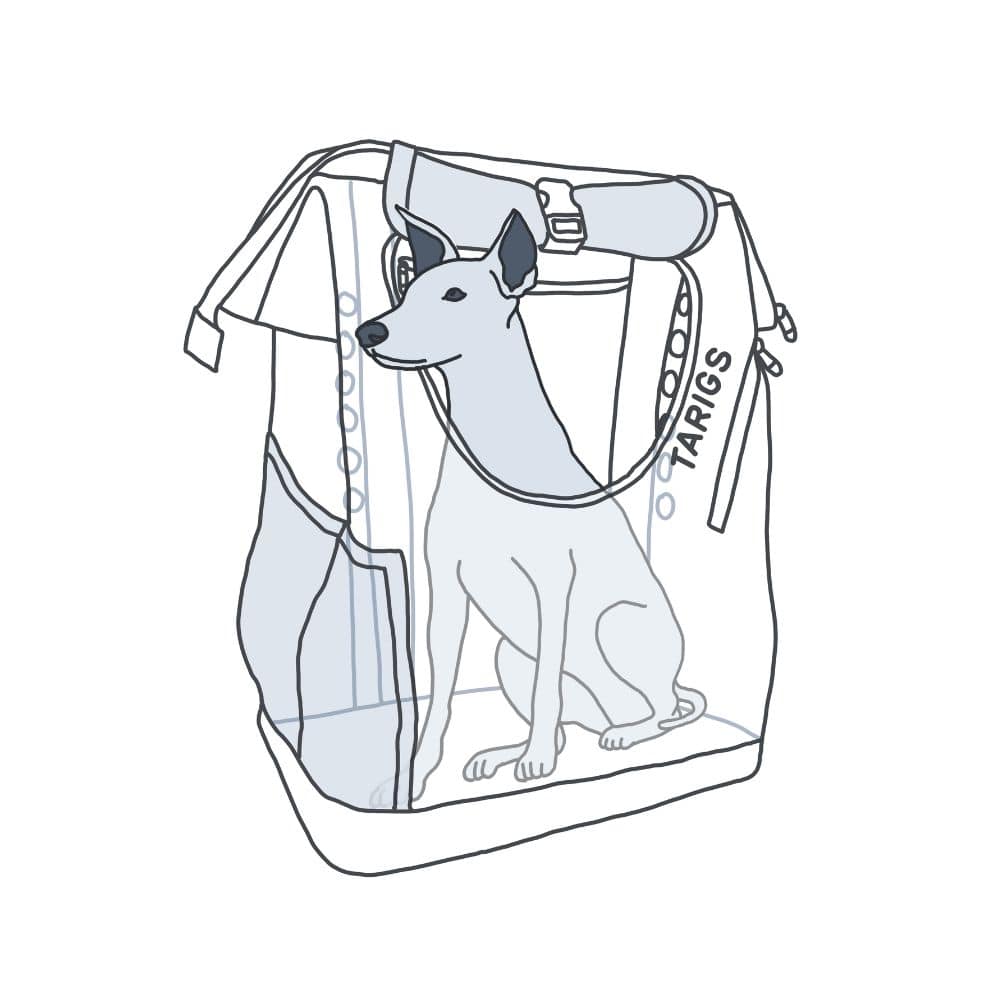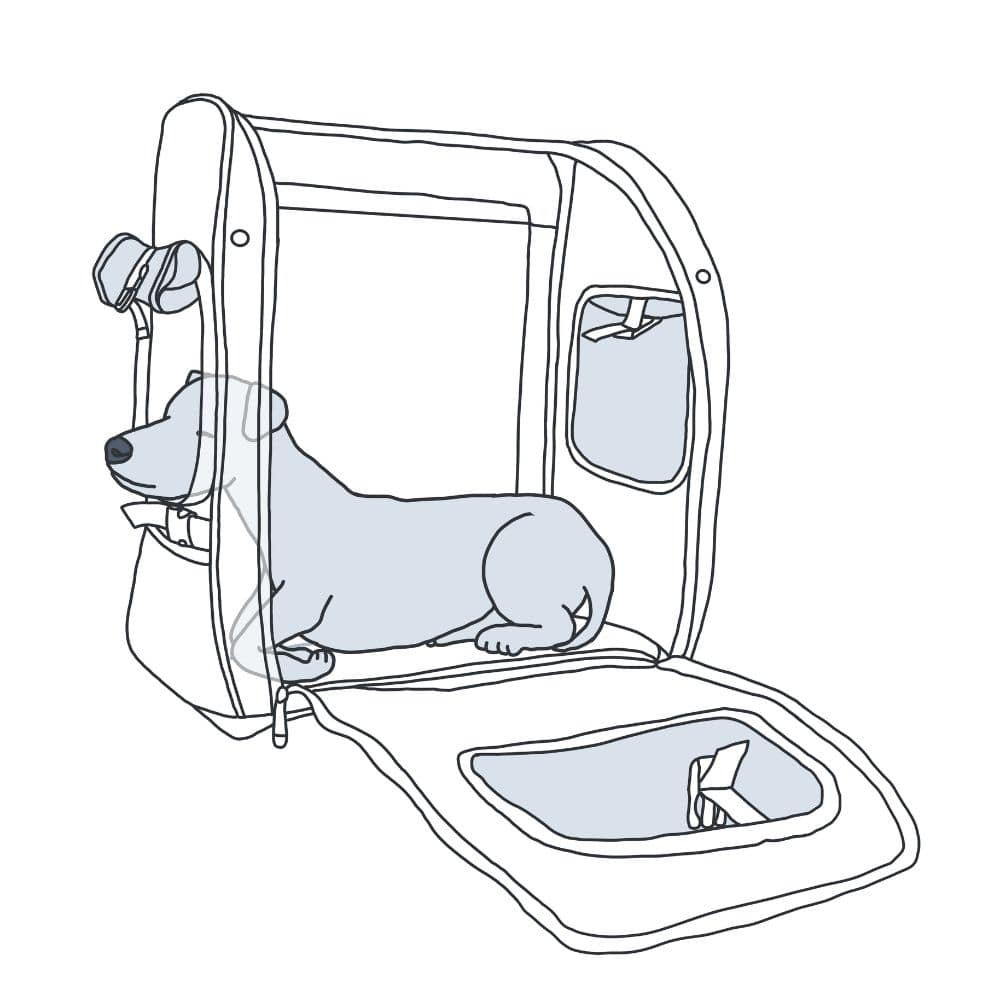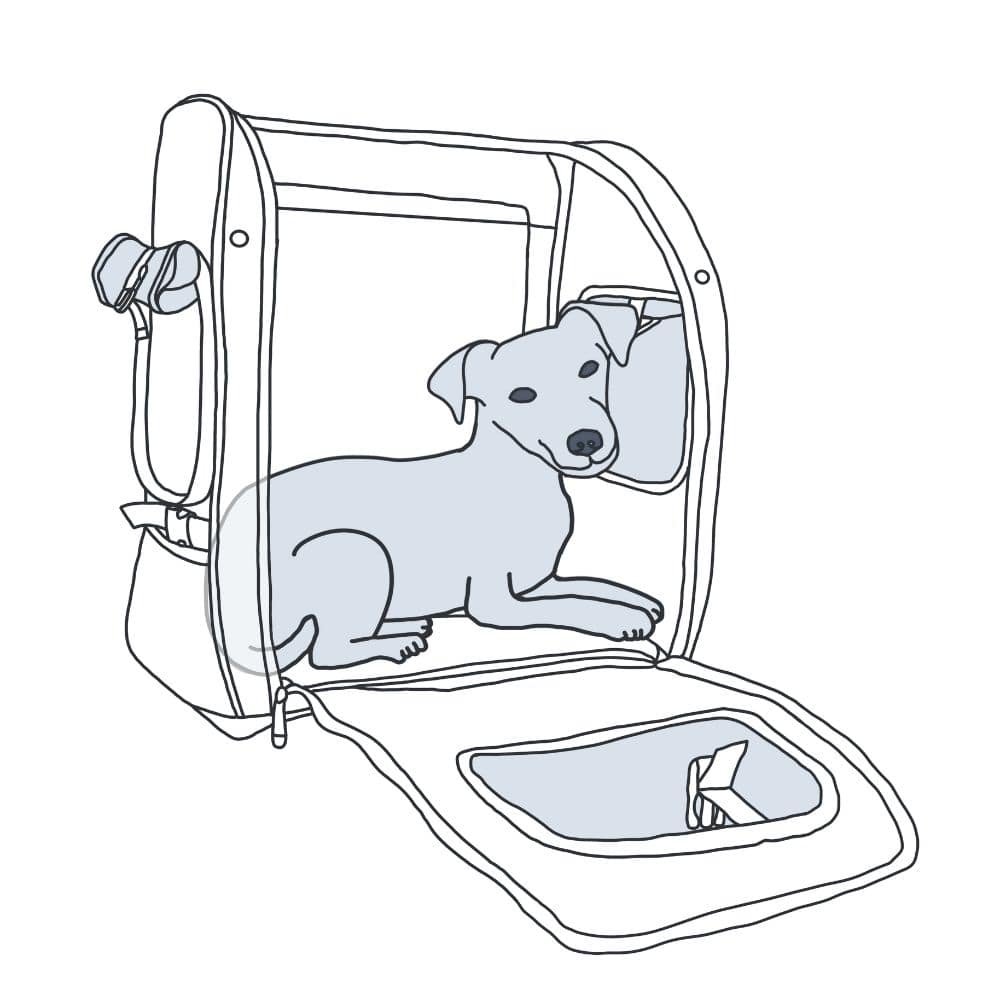The perfect dog carrier backpack: Why size is more than just a measurement
When it comes to dog carrier backpacks, the first instinct is: Measure, measure, measure. Back length, width, weight. But the perfect fit is far more than just a numbers game. It’s a balancing act between your dog’s objective measurements, your own comfort while carrying, and the subjective expectations you both have for your shared adventure.
Just because the numbers add up doesn’t automatically mean the backpack will feel perfect for either your dog or you. The ideal fit comes from the interaction between dog, human, and your respective expectations.

Sitting or Lying Down: Your Dog Adapts
Dogs often move differently in a backpack than we imagine. They are true masters of adaptation:
- Curling Up & Tucking In: Many dogs love to snuggle up, tuck their paws close to their body, and curl up almost like little balls. This is true even for dogs who normally stretch out when lying down.
- Sitting or Lying: Some sit upright to observe their surroundings, while others prefer to lie down as soon as they get tired.
Important Tip:
Don’t expect your dog to lie fully stretched out in the backpack like they do on their dog bed. Most dogs don’t lie completely flat but instead find a cozy, secure position. This way, they stay compact and safe.
Backpack Models and Typical Positions
Different models offer different seating options:
| Example Model | Typical Sitting Position | Notes |
|---|---|---|
| PeakStone, Dachshund, Bulldog | Dog sits or lies crosswise from one side window to the other | Provides more length/width space, better for lying down |
| MountainRock | Dog sits diagonally forward | Good for dogs who like to sit and look ahead |
| ROOFPACKER | Dog can sit crosswise or facing forward | Maximum flexibility in positioning |

The models PeakStone, Dachshund, and Bulldog Backpack are designed for the dog to sit or lie crosswise to the carrier’s direction of movement. As shown schematically in the illustration, this orientation allows for optimal use of space: the dog lies or sits sideways, making full use of the backpack’s width. At the same time, they can comfortably look out through the side mesh windows.

For our MountainRock Backpack, the position shown is typical: the dog sits diagonally facing forward in the backpack.
Despite this preferred sitting position, some dogs may also lie down in the MountainRock Backpack. Whether this is comfortable depends greatly on the dog’s individual body shape and, of course, personality—some prefer to stay upright, while others like to curl up and doze.
Possible Lying Positions in the
PeakStone Backpack, Dachshund Backpack, Bulldog Backpack:

The dog lies stretched out with its paws tucked in, with its head comfortably sticking out of or resting on the side mesh window. This position provides a sense of security and allows the dog to attentively observe its surroundings or simply enjoy the fresh air.

This relaxed lying position in the backpack is the most comfortable way for many dogs to travel longer distances. The dog lies crosswise to the direction of movement and twists slightly for maximum coziness.
Important Considerations Before Buying: The Compromise
The ideal backpack size is always a compromise. Physical limits cannot be bypassed: a larger backpack provides more room for your dog, but also more volume and usually more weight (dog + backpack) for the carrier.
What you should realistically consider:
- Dog size and weight: Are you willing and able to comfortably carry the total weight (dog + backpack) on longer trips, depending on the activity?
- Your dog’s preferred position: Should your dog be able to lie down or sit? Which lying position suits your dog best?
- Comfort for the human carrier: Should the backpack be as compact as possible, or is a slightly larger size acceptable?
- Purpose of the backpack: Hiking, cycling trips, public transport, air travel, city walks, etc.?
Important: A dog that fits perfectly in a Large size will not fit in Medium—no matter how much you wish it would.
For example, if your dog is very long or needs to stretch out completely, the backpack will inevitably be larger and feel bulkier than a smaller option.
Assuming the backpack fits your dog and your individual requirements perfectly, we therefore always recommend and prefer the smaller alternative.
Tip: Our quiz will help you find the model that fits you and your dog perfectly in just a few steps.
Exceptional Scenarios: When Measurements and Feelings Aren’t Everything
The most common challenges arise when measurements (objective) and expectations (subjective) collide. These case examples show you when a willingness to make a healthy compromise becomes necessary.
1. Martin and Lotte – the Dachshund that Doesn’t Quite Fit
- Objective Situation: Martin is looking for a backpack for his dachshund Lotte, who has a 50 cm back length and 24 cm shoulder height. She weighs 11 kg. The Dachshund Backpack Maxi (L) fits objectively according to the size chart.
- Subjective Challenge: Lotte fits very well in this backpack and can lie down, but not fully stretch out like on a dog bed. Martin would like her to lie down without tucking her paws. The next larger option, the Extra Wide Dachshund Backpack, would theoretically solve this. However, when trying it on, Martin finds this backpack too big and bulky.
- Conclusion: Sometimes the best solution is a good compromise. The Maxi (L) size is large enough for Lotte to lie down comfortably and look out, while still being manageable for Martin to carry.

2. Sophie and Max – When Mini Feels Too Big
- Objective Situation: Sophie has a Pomeranian named Max, weighing 3.2 kg. His shoulder height is 20 cm and back length is 32 cm. The Dachshund Backpack Mini (S) fits objectively, since Sophie indicated that she wanted her dog to have plenty of space.
- Subjective Challenge: Max feels “lost” in the backpack; the volume relative to his size is too large. Sophie also finds the backpack too big on her back, even though Max could stretch out as she originally wanted. She prefers a snugger, cozier fit.
- Conclusion: The combination of dog size, carrier size, and expectations is decisive. A backpack may fit objectively but feel uncomfortable subjectively. In this case, the PeakStone Backpack Small is the solution.
3. Lena and Yuki – Is the Dog Too Big for Air Travel…
- Objective Situation: Lena and her Shiba Inu, Yuki, want to have many adventures together. Lena is therefore looking for a backpack that is suitable for in-cabin air travel and meets the requirements of most airlines. That’s why she chose the PeakStone Backpack Medium.
- Subjective Challenge: Yuki is an average-sized Shiba Inu with a shoulder height of 43 cm, back length of 40 cm, and weight of 9 kg. However, the windows of the PeakStone Backpack Medium only reach 40 cm, making the Medium size too small. The PeakStone Backpack Large fits Yuki perfectly.
- Conclusion: Both Yuki and the PeakStone Backpack Large are generally too big or too heavy for in-cabin air travel. Even though Lena wishes to take Yuki in the cabin, this is unfortunately not possible in this case. The best solution is to skip flying, as airline size and weight restrictions cannot be adjusted.


Practical Tips for Choosing the Right Backpack
To balance the needs of both dog and human, consider the following before purchasing:
Cozy and Secure or Maximum Space?
How should your dog feel? Do you want a compact, cozy fit that most dogs prefer, or do you prioritize maximum space and freedom of movement for your dog, which will require a larger backpack volume?
Your Compromise
What compromise in carrying comfort are you willing to make if the backpack is meant to give your dog as much space as possible?
Conclusion: Comfort Matters Most
The fit of a dog backpack is a complex interplay of objective measurements, comfort, and individual perception. It’s not just about the number on a measuring tape, but about ensuring that both dog and carrier feel completely comfortable on their journey together.
In most cases, you will find the TARIGS backpack that fits both of you perfectly. Only in special situations—for example, with very large dogs requiring maximum space, or when a dog’s measurements make strict airline requirements impossible—will a willingness to make a healthy compromise be necessary.
With realistic expectations and our guide, you can find the ideal TARIGS Backpack for relaxed and safe adventures with your four-legged friend.
And don’t forget: tag us on your adventures! #tarigs

